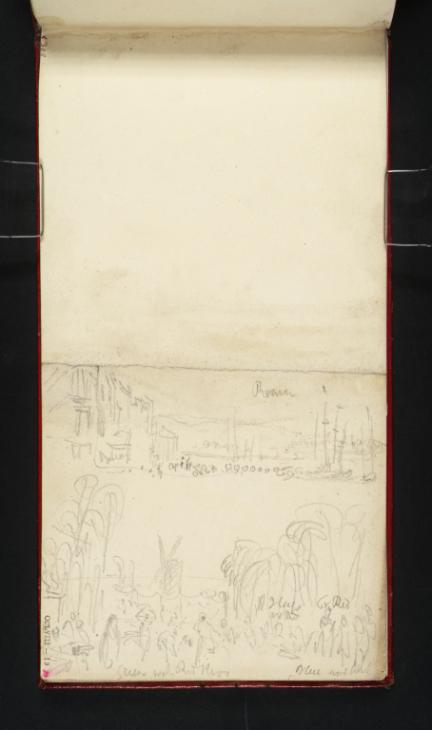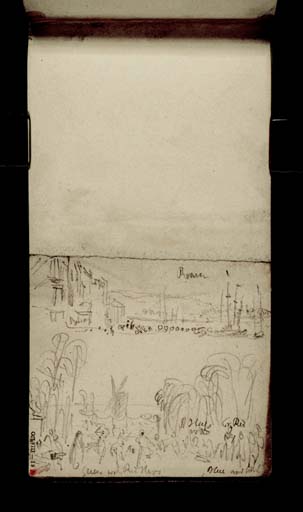Joseph Mallord William Turner Rouen from the Quayside; and Sketch relating to a Watteau-School Painting 1821
Image 1 of 2
Joseph Mallord William Turner,
Rouen from the Quayside; and Sketch relating to a Watteau-School Painting
1821
Joseph Mallord William Turner 1775–1851
Folio 19 Recto:
Rouen from the Quayside; and Sketch relating to a Watteau-School Painting 1821
D24535
Turner Bequest CCLVIII 19
Turner Bequest CCLVIII 19
Pencil on white wove paper, 123 x 118 mm
Inscribed in pencil by Turner ‘Rouen’ centre above the upper sketch; ‘Green with Red Sleeves’ bottom left, ‘Grey | w Red’ and ‘Gr Red’ lower right, and ‘Blue against [?]white’ bottom right
Inscribed in red ink by John Ruskin ‘19’ bottom left descending vertically
Stamped in black ‘CCLVIII – 19’ bottom left descending vertically
Inscribed in brown ink ‘306’ top left descending vertically
Inscribed in pencil by Turner ‘Rouen’ centre above the upper sketch; ‘Green with Red Sleeves’ bottom left, ‘Grey | w Red’ and ‘Gr Red’ lower right, and ‘Blue against [?]white’ bottom right
Inscribed in red ink by John Ruskin ‘19’ bottom left descending vertically
Stamped in black ‘CCLVIII – 19’ bottom left descending vertically
Inscribed in brown ink ‘306’ top left descending vertically
Accepted by the nation as part of the Turner Bequest 1856
References
1909
A.J. Finberg, A Complete Inventory of the Drawings of the Turner Bequest, London 1909, vol.II, p.786, CCLVIII 19, as ‘View of “Rouen”; also sketch of a picture with groups of figures in foreground and a mill in mid-distance – “Green with Red Sleeves,” “Cr, Red,” “Blue and...” ’.
1981
Maurice Guillaud, Nicholas Alfrey, Andrew Wilton and others, Turner in France: Watercolours, Paintings, Drawings, Engravings, Sketchbooks, exhibition catalogue, Centre Culturel du Marais, Paris 1981, p.155 fig.267.
1999
Ian Warrell, Turner on the Seine, exhibition catalogue, Tate Gallery, London 1999, pp.22.
2009
David Solkin (ed.), Turner and the Masters, exhibition catalogue, Tate Britain, London 2009, pp.50, 226 note 30.
There are two drawings on this page. The upper sketch is a view of ‘Rouen’, looking up-river towards Mont Ste-Catherine from the quayside, with a row of circles that have been interpreted as either a row of barrels on the waterfront or the Bridge of Boats that then crossed the river.1 For a list of Turner’s sketches of Rouen in this book, see folio 1 (Tate D24500; Turner Bequest CCLVIII 1).
The drawing beneath has been identified by Ian Warrell as relating to paintings by Jean-Antoine Watteau (1684–1721) and his school. In Turner on the Seine Warrell interpreted the drawing as a free interpretation of a painting in the Louvre by the artist Jean-Baptiste Pater (1695–1736), Watteau’s pupil: Une Fête Champêtre. Réjouissance de Soldats, 1728 (Musée Louvre).2 Warrell has subsequently suggested that the composition may alternatively relate to an unknown version of Watteau’s Actors at a Fair (the principal version is at Schloss Charlottenburg, Berlin).3 Turner’s basic composition could related equally to either painting, though the windmill seems to have been taken from Une Fête Champêtre (with the addition of sails), while the rope or bunting strung along a circle of poles that surrounds it comes straight from Actors at a Fair. Whatever he may have seen in 1821, it is clear that the English artist has only partially copied another painting, inventing his own elements to create a more original composition. Turner’s interest in emulating the manner of Watteau is evident in his noting down of colours that match the typical palette of the French master.4
For Turner’s admiration for Watteau in this period see Selby Whittingham, ‘What You Will; or some noted regarding the influence of Watteau on Turner and other British Artists’, Turner Studies, vol.5, no.1, Summer 1985, pp.2–24; and part two, vol.5, no.2, Winter 1985, pp.28–48; and Warrell 1999, pp.22–23.
Technical notes:
The page has been cut in half and reattached to the sketchbook with a new section at the gutter.
Thomas Ardill
February 2013
How to cite
Thomas Ardill, ‘Rouen from the Quayside; and Sketch relating to a Watteau-School Painting 1821 by Joseph Mallord William Turner’, catalogue entry, February 2013, in David Blayney Brown (ed.), J.M.W. Turner: Sketchbooks, Drawings and Watercolours, Tate Research Publication, August 2014, https://www


